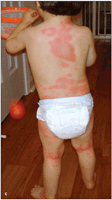- Clinical Technology
- Adult Immunization
- Hepatology
- Pediatric Immunization
- Screening
- Psychiatry
- Allergy
- Women's Health
- Cardiology
- Pediatrics
- Dermatology
- Endocrinology
- Pain Management
- Gastroenterology
- Infectious Disease
- Obesity Medicine
- Rheumatology
- Nephrology
- Neurology
- Pulmonology
Pollen, Animals, Lady Bugs, and Mold: Test Your Allergy Quotient
Allergy triggers are everywhere, always. How well do you help patients cope? This quick test of your allergy quotient may help sharpen your tools.
Question 1:
A 28-year-old woman presents with recent onset of itchy eyes and runny nose. She notes she had similar symptoms at the same time last year and treated herself with over-the-counter antihistamines. You suspect seasonal allergic rhinitis.
Answer and new question on next page »
The correct answer is B. Pollen
For discussion, click here.
Question 2:
Various environmental factors contribute to the severity of asthma, including outdoor allergens. Certain allergens can exacerbate an asthma patient’s symptoms based on the time of year.
Answer and new question on next page »
The correct answer is C. Late summer/autumn-animal dander
For discussion, click here.
Question 3:
An oral food challenge may be the only accurate means of verifying a food allergy when you suspect something other than an IgE-mediated sensitivity.
Answer and new question on next page »
The correct answer is E. All of the above
For discussion, click here.
Question 4:

A 72-year-old woman sees her primary care physician because she has an itchy facial rash of 1 week’s duration. She reports that redness and scaling had developed on her cheek and that vitamin E oil she applied to the area may have made it worse. Possible causes of the rash include an allergic reaction to the vitamin E oil, a flare of seborrhea, a flare of rosacea, and contact dermatitis that is not responding to vitamin E.
Answer and new question on next page »
The correct answer is D. All of the above
For discussion, click here.
Question 5:
For patients with newly diagnosed allergic rhinitis, treatment commonly includes nasal corticosteroids and newer antihistamines.
Answer and new question on next page »
The correct answer is C. Turbinate surgery (reserved for refractory cases)
For discussion, click here.
Question 6:

Circumscribed erythematous lesions developed on the back and abdomen of this 19-month-old boy. The rash was mildly pruritic. His parents gave him 1 dose of diphenhydramine, and the rash resolved after an hour. About 12 hours later, new lesions developed on the face, neck, and upper back. He was given the same treatment, and the symptoms resolved. The next morning, widespread lesions were noted on his face, neck, trunk, and extremities. The recurrent lesions are characteristic of the boy’s condition. Causes include aeroallergens/contact allergens.
Answer and new question on next page »
The correct answer is C. Acute urticaria
For discussion, click here.
Question 7:
Asthma symptoms may be precipitated by exposure to indoor irritants, including house dust mites and mold, which are both sensitive to indoor humidity levels.
Answer on next page »
The correct answer is B. 30-50%
For discussion, click here.
